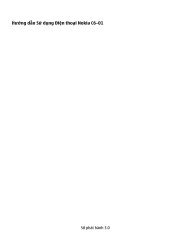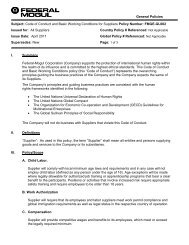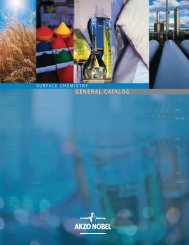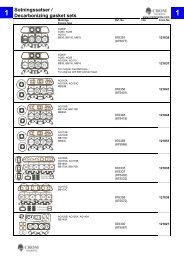You also want an ePaper? Increase the reach of your titles
YUMPU automatically turns print PDFs into web optimized ePapers that Google loves.
A<br />
ENGINEERING<br />
Reliability Life Factor (a 1 )<br />
The equation <strong>for</strong> the life adjustment factor <strong>for</strong> reliability is:<br />
( )<br />
a 1 = 4.26 x ln 100 2/3<br />
+ 0.05<br />
R<br />
ln = natural logarithm (base e)<br />
To adjust the calculated L 10 life <strong>for</strong> reliability, multiply by the a 1 factor.<br />
If 90 (90 percent reliability) is substituted <strong>for</strong> R in the above equation,<br />
a 1 = 1. For R = 99 (99 percent reliability), a 1 = 0.25. The following table<br />
lists the reliability factor <strong>for</strong> commonly used reliability values.<br />
R (percent) L n a 1<br />
90 L 10 1.00<br />
95 L 5 0.64<br />
96 L 4 0.55<br />
97 L 3 0.47<br />
98 L 2 0.37<br />
99 L 1 0.25<br />
99.5 L 0.5 0.175<br />
99.9 L 0.1 0.093<br />
Table 9. Reliability factors.<br />
Note that the equation <strong>for</strong> reliability adjustment assumes there is a<br />
short minimum life below which the probability of bearing damage<br />
is minimal (e.g., zero probability of bearing damage producing a<br />
short life). Extensive bearing fatigue life testing has shown the<br />
minimum life, below which the probability of bearing damage is<br />
negligible, to be larger than shown above. For a more accurate<br />
prediction of bearing lives at high levels of reliability, consult your<br />
<strong>Timken</strong> representative.<br />
Material Life Factor (a 2 )<br />
The life adjustment factor <strong>for</strong> bearing material (a 2) <strong>for</strong> standard<br />
<strong>Timken</strong> bearings manufactured from bearing-quality steel is 1.0.<br />
<strong>Bearings</strong> also are manufactured from premium steels, containing<br />
fewer and smaller inclusion impurities than standard steels<br />
and providing the benefit of extending bearing fatigue life (e.g.,<br />
DuraSpexx). Application of the material life factor requires that<br />
fatigue life is limited by nonmetallic inclusions, that contact stresses<br />
are approximately less than 2400 MPa (350 ksi), and adequate<br />
lubrication is provided. It is important to note that improvements<br />
in material cannot offset poor lubrication in an operating bearing<br />
system. Consult your <strong>Timken</strong> representative <strong>for</strong> applicability of the<br />
material factor.<br />
Debris Life Factor (a 3d )<br />
Debris within a lubrication system reduces the life of a rolling<br />
bearing by creating indentations on the contacting surfaces, leading<br />
to stress risers. The <strong>Timken</strong> life rating equations were developed<br />
based on test data obtained with 0.040 mm (0.00157 in.) oil filtration<br />
and measured ISO cleanness levels of approximately 15/12, which<br />
is typical of cleanness levels found in normal industrial machinery.<br />
When more or less debris is present within the system, the fatigue<br />
life predictions can be adjusted according to the measured or<br />
expected ISO lubricant cleanness level to more accurately reflect<br />
the expected bearing per<strong>for</strong>mance.<br />
As opposed to determining the debris life factor based on filtration<br />
and ISO cleanness levels, a Debris Signature Analysis can be<br />
per<strong>for</strong>med <strong>for</strong> more accurate bearing per<strong>for</strong>mance predictions.<br />
The Debris Signature Analysis is a process <strong>for</strong> determining the<br />
effects of the actual debris present in your system on the bearing<br />
per<strong>for</strong>mance. The typical way in which this occurs is through<br />
measurements of dented/bruised surfaces on actual bearings run in<br />
a given application. This type of analysis can be beneficial because<br />
different types of debris cause differing levels of per<strong>for</strong>mance, even<br />
when they are of the same size and amount in the lubricant. Soft,<br />
ductile particles can cause less per<strong>for</strong>mance degradation than<br />
hard, brittle particles. Hard, ductile particles are typically most<br />
detrimental to bearing life. Brittle particles can break down, thus<br />
not affecting per<strong>for</strong>mance to as large a degree as hard ductile<br />
particles. For more in<strong>for</strong>mation on Debris Signature Analysis or<br />
the availability of Debris Resistant bearings <strong>for</strong> your application,<br />
consult your <strong>Timken</strong> representative.<br />
600<br />
ISOMETRIC VIEW<br />
400<br />
μm<br />
200<br />
0 0<br />
Core Structure 0-5% Bearing Area 5-10% Bearing Area Pits & Valleys<br />
Fig. 46. Surface map of a bearing raceway with debris denting.<br />
200<br />
μm<br />
400<br />
600<br />
800<br />
48 TIMKEN MACHINE TOOL CATALOG







